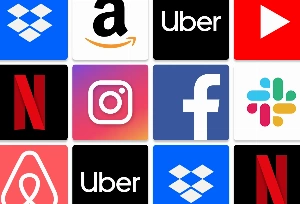Before you choose the platforms, segment your audience by geography. This map showcases the approximate percentage of the users who are more likely to buy iOS apps and make in-app purchases.
For smaller businesses, it would be wise to target a specific audience with either Android or iOS platform app, according to the market share. Those who have more resources can create apps for both platforms.
Another way is to create a cross-platform app using Flutter technology, that will work on both platforms. This approach is often used when creating a minimum viable product.
#3 Create a user-friendly design
UI/UX design is an art. It’s the art of making complicated things easy.
User experience (UX) design is everything that relates to the online experience with your product. User interface (UI), on the other hand, is how pleasant your app is to the eye, and how readable it is.
People are looking for ways that are shorter and simpler. You can provide this via smart design.
#4 Product Development
You can choose either to develop the app by yourself (if you’re a developer), hire in-house or offshore software development company.
A crucial factor that will impact the time and cost of development is how difficult your app is to develop. Hybrid apps are easier and faster to build in comparison with native apps.
At this stage, you should choose a perfect technology stack for your app, which includes frontend, backend, and databases.
In our previous article, we described what a technology stack is and how you can choose exactly what you need for your app.
If you’re new to development, we suggest hiring a dedicated team or outsourcing your project to experts who have hands-on experience in mobile app development for startups. In this case, you’ll have to provide specifications that describe how your product should look and function. The experienced vendor will provide you a few suggestions of what technologies would be better to use and set up the startup mobile app development process.
#5 Funding your mobile app
If you’re just a beginner in entrepreneurship you may be not sure what type of funding to choose. Knowing how and when to apply for funding can considerably increase your chances of winning the deal.
- Bootstrapping. It’s a way of funding when an entrepreneur uses little capital (rarely outside investments, usually only personal finances) to maintain the startup. Bootstrapping is beneficial because the entrepreneur is able to be in control over all decisions. On the other hand, it can be financially risky. Bootstrapping can be used at the MVP stage. Friends and family can be a source of capital as well.
- Angel investors. Business-angels are individuals that are interested in the investment opportunity in your mobile app in return for the share in your business. Angels invest from 25 000$ to 100 000$ in general when the initial version of the app is launched.
- Venture capitalists. The investment from venture capitalists ranges in millions of dollars. Venture capital investments are provided to the startups with high potential (series A financing), which means that your business and ideas must be validated and tested by users. You can take advantage of these three possibilities to raise money at different stages of your startup.
#6 Do some marketing
Marketing isn’t just one step in your startup journey. It’s a journey itself.
Focus all your energy on your target audience and ignore everyone else. You can reach people via multiple means (blogs, videos, podcasts, pictures) and channels — social media and website.
As a marketer, you must keep social media under the radar. Because if you want people to hear and engage, you must hang out where they hang out. Execute PR and brand awareness strategies at the beginning — it will help you to become known and provoke interest.
Make a step forward
Doesn’t matter at what phase of your startup development you are, if you feel that you need help in design, management, or development — feel free to contact inVerita. Software development for startups is our calling and will be glad to boost your business.






_1758804763-small.webp)
